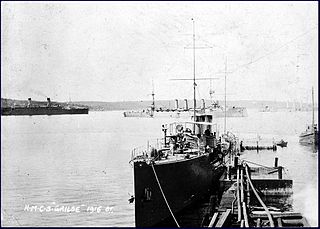
HMCS Grilse was a commissioned patrol boat of the Royal Canadian Navy during the First World War. Launched in 1912 as the private yacht Winchester of the American industrialist Peter Rouss, the vessel was constructed along the lines of a contemporary Royal Navy torpedo boat destroyer. After the outbreak of war, vessels that could be used by belligerents was prohibited by the government of the then-neutral United States. Canadian millionaire J. K. L. Ross purchased Winchester and returned to Canada with the yacht, where he transferred ownership of the vessel to the Royal Canadian Navy. Renamed Grilse, a pseudonym for Atlantic salmon and converted to a patrol boat, the vessel was deployed as part of Canada's east coast patrol combating the German submarine threat. After the war, she was sold back to private interests, re-converted to a yacht and renamed Trillora. Trillora foundered in 1938 at Long Island, New York during a hurricane.
Charles Drown Mower (1875-1942) of New York was a noted yacht designer and author, and was at one time design editor of the Rudder magazine and a contributing author to Motor Boating magazine.

Idealia was America's first diesel powered yacht built and owned by the Electric Launch Company (ELCO). The yacht was built in 1911, launched in 1912 and demonstrated the potential for use of diesel engines in yachts for several years thereafter. She yacht performed a public trial on the Hudson River on 22 October 1913 under the supervision of ELCO's manager Henry R. Sutphen with a gathering of naval architects and engineers as observers. Idealia was sold to individual owners after its period of demonstrating the diesel engine's pleasure craft utility.
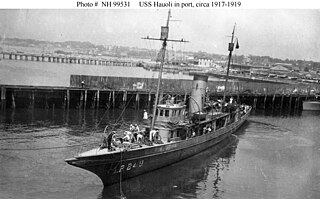
USS California (SP-249) was a yacht acquired by the United States Navy during World War I and outfitted as an armed section patrol vessel patrolling New York waterways. Later, renamed the original name of Hauoli, it was assigned to Thomas A. Edison conducting underwater listening experiments related to antisubmarine warfare.
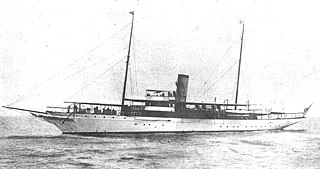
USS Lydonia (SP-700) was United States Navy patrol vessel in commission from 1917 to 1919 that saw service during World War I. Prior to her U.S. Navy service, she had been William A. Lydon's private yacht, Lydonia II, from 1912 to 1917. She spent most of the war based at Gibraltar, escorting and protecting Allied ships in the Mediterranean and along the Atlantic Ocean coast of Europe. After her U.S. Navy service ended, she served from 1919 to 1947 in the United States Coast and Geodetic Survey as the coastal survey ship USCGS Lydonia (CS-302).

USS Zenith (SP-61) was an armed motorboat that served in the United States Navy as a Section patrol vessel from 1917 to 1918.

The second USS Tacony (SP-5) was an armed yacht that served in the United States Navy as a Section patrol vessel from 24 May 1917 to 29 November 1918. The yacht had been built in 1911 by the Mathis Yacht Building Company at Camden, New Jersey for John Fred Betz, III, of Essington, Pennsylvania and member of the Philadelphia Yacht Club as Sybilla II. The vessel was Mathis yard number seven with 208469 the official number issued.

USS Kajeruna (SP-389) was a patrol vessel that served in the United States Navy from 1917 to 1919. The vessel had been built in 1902 as Hauoli for mining magnate Francis Marion "Borax" Smith but was replaced in 1903 by a second, larger vessel he named Hauoli. The first yacht was then named Seminole and for a time was returned to the builder, John N. Robins, and advertised for sale by the designer's firm. In 1911 Clinton W. Kinsella of New York purchased the yacht, apparently already renamed Kajeruna. After naval service the yacht was returned to the owner. On 31 March 1920 the ship was sold to British interests and renamed Tomas W. Beattie.

USS Ameera (SP-453) was a United States Navy Section patrol vessel in commission from 1917 to 1919.
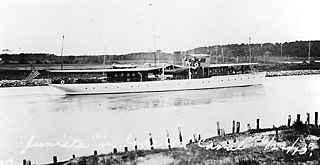
The second USS Juniata (SP-602) was a United States Navy patrol vessel in commission from 1 June 1917 to 13 July 1918. Juniata was built as the private gasoline-powered motor yacht Josephine for Edward Shearson of New York by Robert Jacobs at City Island in the Bronx, New York, in 1911. She was sold in 1914 to George W. Elkins of Philadelphia and renamed Juniata.

USS Marold (SP-737) was a United States Navy patrol vessel in commission from 1917 to 1919.

Charmian II was an express cruiser owned by C. Huges Manly of Baltimore built in Annapolis, Maryland by Chance Marine Construction Company and in September 1915 thought by boating observers after trials to be perhaps the fastest cruiser in her class in the United States. The 59 ft (18.0 m) cruiser was the largest V-bottom cruiser at the time. Manly was a member of both the Baltimore Yacht Club and Maryland Motor Boat Club with Charmian II a part of both fleets.
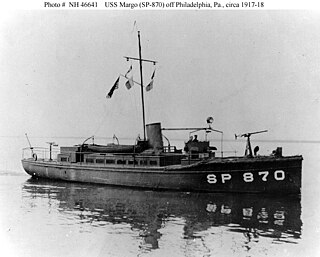
USS Margo (SP-870) was a raised deck cruiser built for private use taken into the United States Navy as a Section patrol vessel in commission from 1917 to 1918 and returned to the owner after the war.

The Barnett-class lifeboat consists of three types of non self-righting displacement hull lifeboats operated by the Royal National Lifeboat Institution (RNLI) from its stations around the coasts of the United Kingdom and Ireland between 1923 and 1987.

The C&C Custom 62 is a Canadian sailboat, that was designed by Robert W. Ball of C&C Design for long range cruising and first built in 1981.
The Landfall 43 is a Canadian sailboat that was designed by Robert W. Ball, the chief designer of C&C Design, and first built in 1982. The Landfall 43 was built with the charter trade in mind, to compete with Morgan and Whitby’s centre cockpit models. The Landfall series, begun with the Landfall 43's predecessor the Landfall 42, was part of a trend within C&C Yachts during the later 1970s and early 1980s to develop more cruising-oriented designs under company president George Cuthbertson's direction.
The Dufour 1800 is a French sailboat that was designed by Laurent Cordelle and Michel Dufour as a trailerable cruiser-racer and first built in 1979.
The Corbin 39 is a Canadian sailboat that was designed by Robert Dufour and Marius Corbin as a global circumnavigation cruiser and first built in 1979.
The ETAP 26 is a Belgian trailerable sailboat that was designed by E. G. van de Stadt as a cruiser and first built in 1982.
The S2 8.0 C is an American trailerable sailboat that was designed by Arthur Edmunds as a cruiser and first built in 1975. The number designation indicates the approximate length overall in meters and the "C" indicates "center cockpit".














